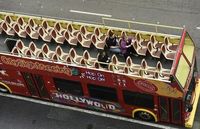Los Angeles, a city famed for its sun-drenched boulevards and star-studded attractions, is facing a tough reckoning as the summer of 2025 draws to a close. Months of negative headlines—raging wildfires, high-profile immigration raids, and unpredictable tariff policies—have culminated in a significant drop in international tourism, deepening the city’s already mounting economic woes. According to data released by Visit California and reported by the Los Angeles Times, international tourist arrivals to Los Angeles fell by 8% in the three months through August, marking a loss of more than 170,000 global visitors compared to the same period last year.
For a region that depends heavily on the steady influx of foreign travelers, the numbers are sobering. August alone saw a 7.5% dip in arrivals compared to 2024, echoing a broader statewide trend that has left major attractions and businesses scrambling to adapt. The most dramatic drop came from north of the border: Canadian visitors, once a reliable summer presence, declined by a staggering 32% over the summer months. The absence of Canadian tourists has sent shockwaves through local economies, particularly in destinations like Palm Springs.
"We've hurt our Canadian friends with actions that the administration has taken. It's understandable," Palm Springs Mayor Ron deHarte told the Los Angeles Times, referencing the Trump administration’s tariffs and inflammatory rhetoric about making Canada the 51st state. "We don't know how long they won't want to travel to the States, but we're hopeful that it is short-term." For Palm Springs, the blow was softened by an uptick in domestic tourism, but other parts of California have not been so lucky.
It’s not just Canadians who are steering clear. Tourists from Australia, China, Germany, and India also avoided California in the summer of 2025, while only Mexican tourists bucked the trend, increasing by about 5% despite ongoing ICE raids. This shift in the makeup of visitors has left its mark on the city’s most iconic locales. On Hollywood Boulevard, where crowds once thronged to rent Ferraris and Porsches for the ultimate Los Angeles selfie, foot traffic for luxury car rentals dropped by nearly 50% this summer. “It used to be shoulder to shoulder out here,” said Salim Osman, who works for Ride Like A Star, an exotic car rental company. “It’s a lot harder for people to come here, or they’re afraid of what’s going on here, so they just don’t come.”
The effects ripple outward from Hollywood’s Walk of Fame. Business has slowed around the TCL Chinese Theater, where tourists traditionally line up to place their hands in the concrete prints of celebrities like Kristen Stewart and Denzel Washington. Sightseeing buses, Madame Tussaud’s Wax Museum, and even the costumed characters who pose for photos have all seen fewer patrons. Souvenir shops, meanwhile, have been forced to raise prices on their wares, squeezed by both tariffs and declining sales.
Negative news has played a starring role in this downturn. The destructive Eaton and Palisades wildfires in January 2025 dominated headlines worldwide, painting a picture of a state under siege. The situation worsened in June, when a series of highly publicized immigration crackdowns made global news, further damaging California’s image as a welcoming destination. According to Dennis Speigel, president of International Theme Park Services, 2025 has been a “soft year” for theme parks nationwide, with fewer international visitors and more Americans opting for staycations. “People in the locales where the parks are stayed in their areas,” Speigel explained. “This summer people stayed home because of the general economy, the media, the tariffs, the confusion and the uncertainty that came with that.”
Yosemite National Park, a perennial favorite among both domestic and international tourists, experienced a decrease of as much as 50% in bookings before Memorial Day weekend. Airport traffic, too, has suffered. Cynthia Guidry, director of the Long Beach Airport, pointed to reduced airline schedules, economic pressures, and rising costs as key factors. She’s now looking for ways to prepare for the 2028 Summer Olympics that don’t rely solely on flight revenue, such as boosting dining and shopping options at the airport. “We’re focused on attracting new service, growing non-aeronautical revenue and managing expenses to stay resilient,” Guidry told the Los Angeles Times.
Despite these headwinds, California’s tourism industry achieved a new high in 2024, with visitors spending $157.3 billion—a 3% increase from 2023—that created 24,000 jobs, according to Visit California’s economic impact report. However, the recent slump in international arrivals has cast a shadow over these gains. Los Angeles Hotel Association President Jackie Filla noted that the city’s hotels are facing a decline in both room occupancy and traveling events, all while grappling with rising labor costs. The hourly minimum wage for hotel workers in California is set to jump to $25 in July 2026, $27.50 in July 2027, and $30 in July 2028, just ahead of the Olympic Games. “Hotels were not back to pre-pandemic numbers when the wildfires hit," Filla said. "The adoption of recent regulations that have steeply escalated labor costs have created additional challenges for hotels and the hundreds of small businesses within them.”
Adam Burke, president of Los Angeles Tourism, emphasized the broader implications for the state. “Los Angeles is California’s primary international gateway; the impacts are felt statewide,” he told the Los Angeles Times. “Looking ahead, long-term recovery will depend on global economic conditions and how the U.S. is perceived abroad.” It’s a sentiment echoed by industry insiders and city officials alike, who are keenly aware that the city’s reputation on the international stage is as important as its glittering attractions.
For some, however, the draw of Los Angeles remains irresistible, even in the face of grim headlines. Australian tourists Geoffrey and Tennille Mutton brought their two daughters to L.A., despite warnings from friends and family. “A lot of people have had a changed view of America,” Geoffrey said, enjoying ice cream outside Hollywood’s Dolby Theater. “They don’t want to come here and support this place.”
With the World Cup scheduled for next year and the Olympics looming in 2028, the stakes for Los Angeles couldn’t be higher. The city’s leaders are betting that the allure of its world-class events and iconic scenery will eventually outweigh the negatives. But as 2025’s summer slump makes clear, the road to recovery will be anything but straightforward.

